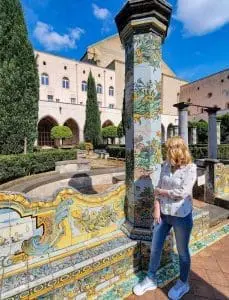 Our love for Italy grew during 2022 because we took a number of cruises which stopped in Italian ports, one of them being Naples. During our trip we didn’t actually go into the city, instead choosing to visit Pompeii and Amalfi, but we always knew we wanted to return and see the region properly.
Our love for Italy grew during 2022 because we took a number of cruises which stopped in Italian ports, one of them being Naples. During our trip we didn’t actually go into the city, instead choosing to visit Pompeii and Amalfi, but we always knew we wanted to return and see the region properly.
Thankfully we got that chance in March 2024 when we found bargain flights, accommodation and hire car for a week. During that time, we visited most of the Amalfi coast, Pompeii, Herculaneum and Naples.
If you’re interested in finding out more about the other areas we visited, then check out our guides to Pompeii, the Royal Palace of Caserta, and the Amalfi Coast. We have also written a guide on Renting and Driving a Car in Amalfi.
Because Naples is such a big place, we wanted to make sure we gave it an adequate amount of time to see as much as possible. We chose to use up one day of our trip just for Naples, but there are enough things to do and see if you wanted to head there for a couple of days.
After booking our trip we were told by a number of people that they hadn’t really enjoyed Naples. Many felt it was unsafe to walk around and grimy, with lots of litter and graffiti. This meant that we headed there with pretty low expectations of the city itself, and purely went to tick off our list of attractions.
So why even bother with Naples? To start it’s the third largest city in Italy after Rome and Milan. It also has significant historical importance, having been founded by Greeks in the 1st century BC, making it the oldest continuously inhabited urban area in the world. In fact, Naples has been a UNESCO World Heritage Site since 1995 due to its history and significant sites such as the Royal Palace of Caserta, Pompeii and Herculaneum.
For most people heading to Amalfi, Naples is a great place to base themselves, especially if you choose not to drive. Not only will you have access to plenty of amenities such as shops, bars and restaurants, but also amazing public transport links to the rest of the region. Because we had hired a car, we chose to stay in a more rural area called Agerola which was in the mountains and halfway between Naples and Amalfi. Of course, you may pay more for accommodation in Naples than the smaller towns elsewhere. Our advice is to decide how you’ll get around the area first, then the sights you want to see and finally you can work out the best location to stay.
With hindsight we can say that we didn’t have the same negative views about Naples as others, but we can understand why there is a love hate relationship. Aswell as being a densely populated city, with what feels like endless interconnecting streets. It can be quite run down in areas and strewn with graffiti and rubbish. But if you look past that and see the history and architecture all around you, then there is so much to enjoy.
As we have mentioned above, we would recommend at least a day to navigate the city and see its main sites, but there is plenty to do if you’re there for a couple of days or a weekend. It’s worth prewarning you though that of all the areas we visited along the coast, Naples was by far the most expensive for attractions. We never mind paying for an attraction if we feel it was worth what we paid, and that’s normally the case. But during our day in Naples, we felt that the attractions were overpriced for what you got, of course, that’s a personal opinion and you may enjoy them more than we did.
Ad Disclaimer!
This website uses paid adverts and affiliate links, these come at no additional cost to you and help us to fund the operation of the website, meaning we can continue to provide you with valuable content.
The money received from these links and adverts do not influence any recommondations made within our content.
Page Contents
When to Visit Naples
The best part of Naples is that it’s a great place to visit all year round, with mild temperatures and low levels of rain in both the summer and winter. We’re always big fans of travelling in the spring and autumn months, so that’s more specifically March and April, or September and October. Mainly because the weather should be nice and the tourist spots not too busy. The summer in Italy is incredibly hot, so we recommend staying away, but especially because the Amalfi Coast is a popular destination for holidaying Italians.
It’s worth noting that there are holidays in Italy which can interrupt your trip such as Easter, so double check online before you book. Thankfully we went the week before the Easter holidays, missing the busy roads, but still enjoying some of the festivities in the build-up.
Also, if you go in the winter season, leading up to March, there is a chance that some public transport options will be limited such as the ferries, and shops or restaurants will be closed.
Best Area to Stay in Naples
We’ve all had the same experience, where you’ve booked the flights and now you’re ready to look at accommodation, but you have no idea which area to stay in. Although we didn’t stay there, we have researched the best areas in Naples to provide you with a full guide.
For your first trip the best place to stay is the Naples’s Centro Storico which is the historic centre and where the majority of the attractions are. This is where you can enjoy the authentic Naples experience, with cobblestoned alleys, beautiful Piazzas and medieval buildings. Because you’re in a busy tourist area you can find prices to be a little higher than other locations, but there is plenty to choose from whether you’re willing to pay for luxury, or you’re on a budget.
If you’re looking for a combination of city break and relaxation, then you may prefer the Piazza del Plebiscito. It’s close to Centro Storico and Quarteri Spagnoli, but you’re also close to the sea. Again, there are plenty of accommodation options for all budgets including hotels, apartments and hostels.
If the cost is really important, then you can stay a little further out of Naples centre and get the metro in each day. Spots such as Via Toledo and Quartieri Spagnoli offer an opportunity to witness the authentic Neapolitan life, whilst having a number of budget friendly hotels.
Things to Do in Naples from a Cruise Ship
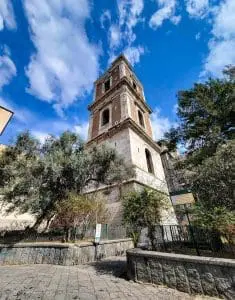 We wanted to ensure we covered everyone, because some of you may be visiting Naples but instead of flying in you’ve arrived via a cruise ship. Naples is one of the most popular cruise ports in Europe and it’s easy to see why, you have the whole of the Amalfi Coast and incredible tourist attractions such as Vesuvius and Pompeii at your fingertips. In fact, our first time in Naples was during a cruise and it’s the reason we decided to come back for longer.
We wanted to ensure we covered everyone, because some of you may be visiting Naples but instead of flying in you’ve arrived via a cruise ship. Naples is one of the most popular cruise ports in Europe and it’s easy to see why, you have the whole of the Amalfi Coast and incredible tourist attractions such as Vesuvius and Pompeii at your fingertips. In fact, our first time in Naples was during a cruise and it’s the reason we decided to come back for longer.
The cruise terminal in Naples is known as the Stazione Marittima, with most of the large ships docking at the main pier in Molo Beverello near Castel Nuovo. If there is more than one ship, you may dock at berth 21 or 22 on the north pier which is a little further away. If this happens then a shuttle bus should be provided to transport you to the terminal building.
The terminal itself is modern and well equipped with tourist information, cash machines, restaurants, toilets and shopping. You can grab taxis, Uber and tour buses from outside the terminal building. Be careful with taxis because they can take advantage of tourists by driving you on a guided tour of the city so they can charge more.
If you’re ready to hit the ground running and tick off your bucket list of Naples attractions, then right next to Naple’s cruise terminal is Castel Nuovo which is a medieval castle. But if you’re eager to head into the centre of Naples then you’re looking at a ten-minute walk on foot, which really isn’t that far.
There’s also a Hop-On Hop-Off sightseeing bus which leaves outside the terminal building. These can be very hit and miss, so our advice is to research before you arrive and see if you think it’s worth the money. They’re ideal if you have mobility issues and simply want to sit and see a city as you drive around.
If you haven’t booked a cruise tour and you’re thinking of making your own way to other parts of the Amalfi Coast or attractions such as Pompeii and Herculaneum, then Naples is a great spot to start from. They offer a number of methods of transport to the main attractions such as ferry, trains and bus.
If you need any guidance on what to take on your cruise, then check out our guide on What to Pack for a Cruise.
What to Pack for Naples
This isn’t an easy one to answer, because it will depend on the time of year you’re visiting Naples. During the summer it will be incredibly hot, so make sure you wear thin layers, but we’d also recommend a hat to reduce your risk of sun stroke. In the cooler seasons the weather can vary a lot and we found that even if the day started off beautiful and sunny, by the afternoon it could be cloudy and raining. It can be cooler in the winter, so a jacket is needed, but not as cool as Northern Europe. We find layers are the best way to go, because you can remove if too hot and then put back on as the day cools down.
Before you head to Naples, our advice would be to Google the temperature so you can gauge what to wear. It maybe that waterproof clothing is needed and an umbrella, so it’s best to be prepared because Europe can be a little unpredictable when it comes to weather.
As you can imagine comfortable shoes are essential, because as we have already mentioned Naples is huge and you will get a lot of steps in.
Other than clothes, the rest of your case will be the usual items you would take anywhere, such as medication and plug adaptors. You will find plenty of shops to buy bits should you forget anything, so don’t worry too much. We have been told that medications in Italy can be incredibly expensive, so make sure you at least take the basics such as paracetamol and ibuprofen, for the just in case.
Naples Airport
When we arrived in Naples airport, we were surprised by how small it looked from the outside. But when we went inside, we were quite shocked by how much was available. At the start of the trip your priority will be finding transport to wherever you are staying and there are a number of options available. You may have a rental car and if so then you’ll want to head to the car hire section. We have detailed what to do in our Renting a Car in Amalfi and Naples Guide.
Outside across a small road you will find the obligatory lines for taxis, Uber and also the Naples Alibus Shuttle which starts from the airport and stops at the Central Train Station and Naples Molo Beverello Port. The cost for each person one way on the bus is 5 Euros (March 2024), which is quite reasonable, and it departs every 20 minutes. Because we drove, we didn’t take a taxi but from our research there is currently a flat rate of 16 Euros, but our advice is to ask the driver before you get in. The journey into Naples town centre should be a maximum of 20 minutes, but this will depend on traffic.
Getting to Naples from Other Parts of the Amalfi Coast
By Car
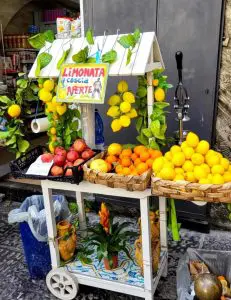 The route you take will obviously depend on which direction you are coming from, but generally it should be the A1. If you’re driving anywhere from the Amalfi Coast, then we would strongly recommend using the toll roads. They cut down the length of the drive and keep you away from the towns which can get incredibly congested with traffic. Yes, driving in the entire area is an experience which can be quite scary and fun at the same time. Italians have an incredibly relaxed attitude as they drive and will simply veer out into various lanes without considering other cars around them. So, you need to be conscious and aware more than usual. Also, there is a lot of beeping as you drive, but unlike other countries where it is a sign of anger, in Italy it’s simply to warn you that they are there.
The route you take will obviously depend on which direction you are coming from, but generally it should be the A1. If you’re driving anywhere from the Amalfi Coast, then we would strongly recommend using the toll roads. They cut down the length of the drive and keep you away from the towns which can get incredibly congested with traffic. Yes, driving in the entire area is an experience which can be quite scary and fun at the same time. Italians have an incredibly relaxed attitude as they drive and will simply veer out into various lanes without considering other cars around them. So, you need to be conscious and aware more than usual. Also, there is a lot of beeping as you drive, but unlike other countries where it is a sign of anger, in Italy it’s simply to warn you that they are there.
What we loved about areas such as Naples is that we couldn’t really make a mistake. If we got into the wrong lane then we could push into the right one and no one battered an eye lid. There was very little ‘road rage’ from our experience, we found it to be more of a controlled chaos. But as the week went on, we adapted quickly to the local rules and found it quite a fun experience.
If you choose to drive into Naples, then you’ll have to think about where you’re going to park. There are plenty of options all over the city, but it may be wise to head in early and prebook your space to make sure you get one. It’s normal in this part of the world to leave your keys with the parking attendant who will then move it to a space for you, but just double check online before you do so. We instead chose a self-park option close to the ferry port and for a very good reason. We had read a number of reviews for car parks in Naples which said that many people had been given their hire cars back damaged. Because of this we felt it was safer to park ourselves, even if it was slightly more expensive. Scrapes are part of everyday life in this region, and they tend to be left because repair prices are quite high. Obviously, we would always recommend additional insurance just in case, but we felt it was better to reduce the risk of damaging the car by self-parking, than having to deal with the car hire company. Our cost to park for the day in Naples for 20 Euros, which for a large city isn’t too bad, especially when you consider that Positano was 6 Euros per hour and that is a small town.
By Train
Naples main train station is called Napoli Centrale, and it has a number of routes all over the region. Taking the train is ideal if you’re staying in a major town such as Pompeii or Sorrento, because there are direct routes into Naples on a regular basis, every day. For the smaller coastal hotels, you’ll find it a little harder, because you will either need to get to a train station via bus, or the stations will be much smaller and you will need to change trains at some point.
By Bus
The bus system in that area is called SITA and the route you take will obviously depend on where you are leaving from. There are bus schedules available online, but just be aware that if you are staying in one of the coastal towns and heading into Naples, then you may need more than one bus. Also, during the busier times of year, the buses can be full, and you may have to wait for the next one.
By Ferry
Travelling by ferry is incredibly popular along the coast of Amalfi, especially too and from Naples. Depending on the time of year and where you are travelling from, it can actually be the cheapest and fastest method of transport. Of course, this is only an option if you’re staying on or close to one of the coastal towns such as Amalfi or Positano. For most towns you will spot huts near the ferry port where you can purchase your ticket. They tend to have the prices and times of the next ferry displayed. Just make sure you ask the times for the return ferries, because you don’t want to miss the last one from Naples.
Private Transfer
Although this is a more expensive option, it’s still one which may suit you if you’re not keen on driving but you’re looking for ease. You can wait until you’re in Italy, but we would always recommend prebooking so you can ensure the tour operator is decent. We have used Viator in the past, so that’s a great starting point for you, but make sure you shop around. The best part of a private tour is you’re picked up from your accommodation and dropped off in the city centre. But then they will pick you up whenever you choose and take you back to your accommodation. You don’t have to worry about parking, and you could even enjoy a limoncello or two as you take in the sights of Naples.
Getting Around Naples
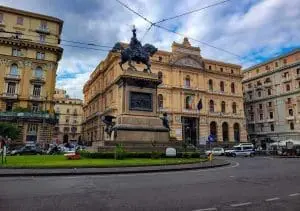 Yes, Naples is a city and as such it is huge, but what you will find is that most of the main attractions are close to each other and as such are in walking distance. This is why it’s the ideal place to simply walk, especially around the winding small, cobbled streets. They offer the quintessential Italian vibe, which us tourists are eager to enjoy.
Yes, Naples is a city and as such it is huge, but what you will find is that most of the main attractions are close to each other and as such are in walking distance. This is why it’s the ideal place to simply walk, especially around the winding small, cobbled streets. They offer the quintessential Italian vibe, which us tourists are eager to enjoy.
Although there isn’t a central bus station in Naples, Piazza Garibaldi is the main hub for buses and trams. Within the piazza you’ll find a bus stop to most intersections, with buses running from around 5am to 11pm. You can buy tickets from the tabacchi (tobacco stores), news kiosks and ticket machines. But they must be validated when you board the bus by inserting them into a small ticket machine which stamps the time and date.
If you want to see further afield in Naples, then there is a metro service with trains running from about 6am to 11pm. There are two Metro lines, the first from Napoli Centrale to Vomero and the Northern suburbs, with a number of stops along the way. The second runs from Gianturco and ends in Mergellina, again with a number of stops including Napoli Centrale. Tickets for the Metro can also be purchased from tabacchi (tobacco stores), news kiosks and ticket machines at the Metro stations.
But if you’re generally looking at visiting attractions in the downtown area and you have full mobility, then our advice is to put on those comfy shoes and simply wander about. We use Google maps to help us find our way from each thing we want to see; it cuts down on getting lost.
Attractions and Things to do in Naples
Once all the preparation for your trip is done, then you’ll be ready to focus on the amazing things to see and do in Naples. This is the most important part of any guide, because essentially, it’s the reason you’re travelling to the city in the first place. If you’re in Naples as part of a cruise then there’s only so much you can fit into the duration you’re docked, but if you’re staying in Naples then we think you can get most of it done in a couple of days.
Naples offers a little of everything, from grand cathedrals, baroque churches, beautiful piazzas and incredible world-renowned artwork. But if you feel like there’s a little too much architecture and history in your trip, then you can always throw in a stop at a restaurant or some shopping.
Here’s our list of the best things to do when visiting Naples.
Naples National Archaeological Museum
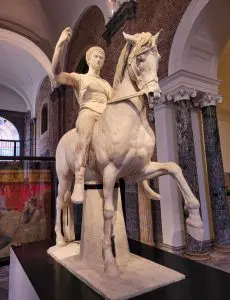 For many visitors to Naples the National Archaeological Museum is a must visit, more so because it offers a large collection of items from Pompeii and Herculaneum. We will begin by saying that this was one of the museums that we questioned whether to even go in, purely because of the price. At the current price of 25 Euros each, we debated whether it would be worth the money, but we were eager to see the Pompeii artifacts after having been to the site itself. After you have bought your ticket and purchased an audio guide (if you choose to), then you will head into the museum. Make sure you have a map because the building is huge, also if you have a rucksack you need to take it to the cloakroom and leave it there at no extra charge. Opening hours are between 9am and 7.30pm, with the museum being open every day apart from Tuesday.
For many visitors to Naples the National Archaeological Museum is a must visit, more so because it offers a large collection of items from Pompeii and Herculaneum. We will begin by saying that this was one of the museums that we questioned whether to even go in, purely because of the price. At the current price of 25 Euros each, we debated whether it would be worth the money, but we were eager to see the Pompeii artifacts after having been to the site itself. After you have bought your ticket and purchased an audio guide (if you choose to), then you will head into the museum. Make sure you have a map because the building is huge, also if you have a rucksack you need to take it to the cloakroom and leave it there at no extra charge. Opening hours are between 9am and 7.30pm, with the museum being open every day apart from Tuesday.
You will find as we did that it’s difficult to know where to start, so we just went to the closest rooms on the map and worked our way around. The Naples National Archaeological Museum has four floors, with two being devoted to Pompeii and Herculaneum. Within this area there is a model and computer animation of how Pompeii would have looked and a brief video explaining the tragedy that struck, which we found fascinating. When it comes to actual artifacts from the area there are numerous rooms with furniture, statues, impressive mosaics, paintings and papyrus scrolls. If you don’t get the chance to actually visit Pompeii itself then the Archaeological Museum is another option to engross yourself in the history of the event. They even have a plaster cast of a victim who is frozen in their final moment of life, which is a stark reminder of the power of mother nature.
The rest of the museum has a huge collection of work from Greek, Roman and Renaissance eras, such as the Farnese Collection which includes engraved gems and Farnese Marbles. The greater section of the museum consists of marbles and sculptures, many of which are vast in size and incredibly impressive to witness firsthand. Theres even an Egyptian Collection with some incredible items including mummies, which we found astounding and slightly creepy to see close up.
If you’re looking for something to eat, then there is a café with a small selection of hot/cold food and drinks, and a shop with a variety of the usual items.
We’ll admit that after a while we got a little bored of seeing room after room of marble sculptures, even though they were impressive. Even the Pompeii section didn’t create the awe we expected, but maybe we had hyped it up in our heads a little. If you wander around the museum quickly it’ll probably still take you a couple of hours to see everything. Whether you should bother going and paying the entry charge will be down to how much you enjoy art and sculptures. We felt that for us it wasn’t worth the cost, although we may be complete philistines and didn’t appreciate the displays as much as others would. The Naples National Archaeological Museum is world famous for its range of collections, so purely for that, it may be worth adding to your bucket list.
Church of Santa Chiara and the Majolica Cloister
Heading to the church and cloisters we had no idea what to expect, but we’ll begin by saying that this is one of our favourite things in Naples. It’s quite a busy area with sellers and entertainers on the street, plus the tourist traffic from the nearby Gesu Nuovo church. We did feel a little cautious in the area, especially because we had read that pick pocketing is common in Naples. But once you’re in the church area it felt much safer.
Santa Chiara is the name of the actual religious complex which includes the church, monastery, cloister, tombs and archaeological museum. The church was built in 1340 with a Gotico Angioiano style, but this evolved during the 17th century to the atypical Baroque style you will find in many other Italian religious buildings. Sadly, during World War II Santa Chiara was partially destroyed by bombings, but restoration was completed in 1953. In comparison to many other churches in Amalfi, or in fact Naples itself, this isn’t the most elaborate and you probably won’t spend a lot of time there. But it’s free to enter so it’s worth popping in to see the architecture and the tomb of King Robert which can be found behind the main altar. You can access the church Monday to Saturday between 9.30 am and 5.00pm, but because this is a church it’s important to remember that there may be parishioners there.
Heading down the outside of the church you will find a ticket office, and this is the entrance to the Santa Chiara Majolica Cloister. The cloister is open between Monday and Saturday from 9.30am to 5pm, and on Sunday 10am to 2pm. Tickets to enter currently cost 7 Euros, but this gives you access to the cloister, museum, archaeological site, library, video room and a nativity scene from the 1700’s.
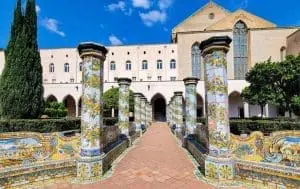 Once you’re through the ticket office you will enter the cloister of the Clarisses, which is the main attraction and certainly worth the cost. The beautiful cloister arcades around the sides are decorated by 17th century frescoes, but it is the criss-crossed walkways in the centre which really stand out. Both the colonnades and 72 benches are decorated with majolica tiles which were added in 1742 and are lined with blossoming orange trees. The tiles painted by Donato and Giuseppe Massa, depict typical 18th century rural Neapolitan scenes and are simply beautiful to witness; plus, they are perfect for a photograph as they exude Italian vibes. Although much of the walkway consists of tiled seats, you will see signage everywhere informing you not to sit down. The tiles are delicate and as such need to be protected, but sadly during our time there many visitors ignored the signs and sat down for pictures. There are staff walking around and monitoring the walkways and you will be told to stand up.
Once you’re through the ticket office you will enter the cloister of the Clarisses, which is the main attraction and certainly worth the cost. The beautiful cloister arcades around the sides are decorated by 17th century frescoes, but it is the criss-crossed walkways in the centre which really stand out. Both the colonnades and 72 benches are decorated with majolica tiles which were added in 1742 and are lined with blossoming orange trees. The tiles painted by Donato and Giuseppe Massa, depict typical 18th century rural Neapolitan scenes and are simply beautiful to witness; plus, they are perfect for a photograph as they exude Italian vibes. Although much of the walkway consists of tiled seats, you will see signage everywhere informing you not to sit down. The tiles are delicate and as such need to be protected, but sadly during our time there many visitors ignored the signs and sat down for pictures. There are staff walking around and monitoring the walkways and you will be told to stand up.
At the back of the cloister there is an entrance into the museum which was originally the monastery, and it is here that you will find a small shop and toilets if needed. But it’s also an archaeological site and you can head out to see what was an ancient bath from the 1st century. Within the museum there is an array of artifacts which were found on the site, including religious sculptures and materials from the church which survived the fire in 1943. As you head towards the exit, you’ll find the large nativity scene, another small shop and a café serving hot and cold food and drinks, with outside seating to relax in the sunshine.
As we said at the start, we really enjoyed our time in Santa Chiara, it was so picturesque, and we loved the beautiful artwork and architecture, which for 7 Euros is a bargain.
Via San Gregorio Armeno
Although this isn’t necessarily an attraction or activity, it is a popular thing to do for people visiting Naples. Via San Gregorio Armeno is a famous alleyway in Italy because it has a raft of artisan shops selling touristy items, but more specifically nativity scene figures.
Because it’s a popular street you may find that it is incredibly busy, especially as it’s quite small in width. Via San Gregorio Armeno is sandwiched between two of the more popular streets for shopping, namely Spaccanapoli and Via dei Tribunali, so it can be easy to miss. But once you’re on there, you’ll see why it’s a fun addition to our list and worthy of some of your day in Naples. The quaint old shops provide you with an opportunity to find a unique holiday souvenir, but be careful if you visit in the Christmas period because it’s insanely busy.
Gesù Nuovo
Not far from Santa Chiara is the church named Gesù Nuovo or the ‘New Jesus’, which has quite a quirky look to it. The square that the church can be found on also contains another prominent landmark called the Spire of the Immaculate Virgin, which is an impressive sight.
When you see the church, you’ll question whether it’s even a religious building because it has quite a dark look. One of the features of the façade is its structure of small pyramids which was a style heavily used in the Venetian Renaissance, but was generally unknown in the south of Italy.
The building was originally a 15th century palace which was built in 1470 by prince Salerno Roberto Sanseverino. It was eventually sold to the Jesuits at the end of the 16th century to become a church, with construction beginning in 1584. Interestingly they retained the unusual façade which was built for the palace. After the Jesuits were expelled from Naples in 1767, the church was given to the Franciscan Reformation, but was later return to the Jesuits in the 20th century.
During World War II there was extensive damage caused by aerial bombing, with one bomb falling through the ceiling but not detonating; this bomb is still in the church today.
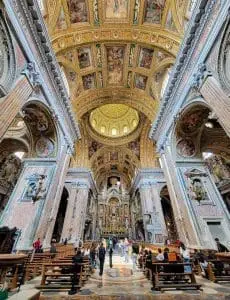 As with many of the churches in Italy, entering the Gesù Nuovo is completely free, and you can visit between 8am and 1pm. It is closed to the public in the afternoon, so that local parishioners can visit in peace.
As with many of the churches in Italy, entering the Gesù Nuovo is completely free, and you can visit between 8am and 1pm. It is closed to the public in the afternoon, so that local parishioners can visit in peace.
This is probably one of the most beautiful churches we have seen, because as well as being large, it has so much intricate detail. The main altar was created by Massino Stanzione and holds the remains of St Joseph Moscati, who dedicated his career as a biochemistry teacher and physician in the early 19th century to healing the poor and was made a saint in 1987. There is a section of the church dedicated to Moscati showing the room where he worked and some of the equipment he used to heal people. Around the rest of the church, you will find various chapels with stunning biblical frescoes, statues and marble.
When you’re back outside the church, head over to the Spire or Guglia of the Immaculate Virgin. It was built to invoke the Virgin Mary’s protection from the plague and was completed in 1750. The design is the atypical Neapolitan Baroque from that era and depicts the birth of the Virgin Mary, Annunciation and the Presentation of Jesus at the Temple.
As to whether you should add this to your Naples list; it’s free, it’s impressive and it has the story of a modern-day saint, so why not.
Pio Monte della Misericordia
The walk to the Pio Monte della Misericordia can be a little windy, up narrow streets, but that’s part of Naples charm. The outside of this popular church is easy to miss, but the first thing you will notice is the queue outside. To enter the church, you have to buy a ticket from the office across the road and then queue during your allotted time slot; yes, it gets that busy. The cost to enter is 10 Euros each which we felt was a bit expensive, especially when the main reason you’re going in is to see one famous piece of artwork. In all honesty if we knew what we know now we wouldn’t have bothered, because it wasn’t worth the cost, as lovely as the painting was. But you may be an art lover and the 10 Euros is worth the price to see Caravaggio’s masterpiece Le sette opere di Misericordia (The Seven Acts of Mercy). If you’re going in to see the church itself then there are others which are far more impressive and free.
Pio Monte della Misericordia is open Monday to Saturday between 10am and 6pm, then on Sunday 9am to 2pm.
If you’re interested in a brief history, in 1601 a charity brotherhood called ‘Pious Mount of Mercy’ was founded and in 1602 they opened a small church, which was consecrated in 1606. The main floor of the church houses the Caravaggio painting at the high altar, but there are many other paintings shown on the first-floor gallery. The other paintings are worth a look, but it’s the Caravaggio which will leave you lost for words.
Cappella Sansevero
We realise our list involves a lot of churches, but to be fair you’re in Italy so there was bound to be a lot of religious architecture. Alike Pio Monte della Misericordia, if you want to visit Cappella Sansevero, it’s probably not specifically for the church itself, but more for the artwork inside. Again, this is a small building, but the price to enter is quite steep for the length of time you’re actually there. The standard ticket price is 10 Euros, and you can visit every day expect Tuesdays between 9am and 7pm. Our advice is to purchase your ticket in advance, because the chapel is small, so they don’t let a lot of people in for each time slot which means spaces sell out fast. If you do just turn up then you may be lucky enough to get a ticket, but there’s lots of people who leave disappointed because it’s sold-out days in advance.
The chapel named Santa Maria della Pieta, contains works of Rococo art by some of the leading artists of the 18th century. Although most people visit to see the three sculptures titled ‘Chastity’, ‘The Disenchantment’ and ‘Veiled Christ’. The Veiled Christ sculpture is the most popular as it portrays Jesus on a bed with a veil over his face taking his last breaths and it is a tomb monument completed in 1752. It’s an incredible sight to behold, but just beware because no pictures or videos are allowed, and staff can be quite strict.
This church dates back to 1590 when John Francesco di Sangro after recovering from a serious illness, has a private chapel built in the gardens of the nearby Sansevero family home. It was converted into a family chapel in 1613, and you can see an inscription on the marble plinth over the entrance of the chapel.
Although the chapel itself is beautiful, your eyes will be drawn to the near 30 pieces of artwork. The ceiling artwork is called the Glory of Paradise which was painted in 1749. The black and white floor is said to symbolise good and evil, with its labyrinth design.
Lungomare
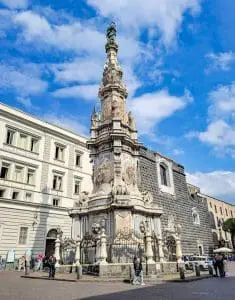 Most big cities can feel a little chaotic at times, but Naples can be especially busy so a great idea if you’re looking for some peace is Lungomare. This is a pedestrianised seafront walk which stretches 2.5km from Via Partenope to Via Caracciolo. During this lovely walk you will see the seafront and cruise port, Mount Vesuvius, two castles and Capri in the distance.
Most big cities can feel a little chaotic at times, but Naples can be especially busy so a great idea if you’re looking for some peace is Lungomare. This is a pedestrianised seafront walk which stretches 2.5km from Via Partenope to Via Caracciolo. During this lovely walk you will see the seafront and cruise port, Mount Vesuvius, two castles and Capri in the distance.
Close to Lungomare is the Villa Comunale, which is a beautiful park with impressive fountains, designed by Luigi Vanvitelli. The park is also home to the Stazione Zoologica which is Europe’s oldest aquarium.
Royal Palace of Naples
Designed in the 16th century, the Royal Palace of Naples was built as a monument to celebrate Spanish glory. When you arrive at the palace you may feel a little disappointed, because it doesn’t have the grandeur which you will find in many other European palaces. But once inside you will be pleasantly surprised by the lavishly decorated royal apartments, which house an eclectic collection of tapestries, sculptures, frescoes and paintings. Upon entering the building, you will see an impressive grand staircase which leads to the second floor where the palace tour begins.
If you want to see the Royal Palace of Naples then you can visit Thursday to Tuesday (it’s closed Wednesdays), between 9am and 8pm. The price to enter is quite reasonable at 11 Euros, especially when you compare it to some of the smaller churches we have already written about above.
The palace was one of the four residences close to Naples, used by the House of Bourbon throughout their reign. During your visit to the palace, you’ll visit the exquisite apartments, including the impressive throne room, the Hall of Hercules, the Apartment of Etiquette, the Staircase of Honour as well as the theatre and chapel.
It’s a great way to learn about the royal rulers of Naples during the last few centuries and explore the luxury and antiques enjoyed at the time. There are gardens and courtyards including the Hanging Garden which has an impressive view of the Gulf of Naples and Vesuvius.
If we had to choose between the Royal Palace of Naples and the Royal Palace of Caserta, then we’d pick the latter. But Caserta can be difficult to get to, so for many the palace in Naples is a great option to take in some royal history.
If you’d like to know more about the Royal Palace of Caserta then we have an extensive guide on how to get there, what you’ll see when you’re there and the facilities available.
Naples Cathedral
If you’ve followed our guide then you may be a little fed up with churches or religious buildings by now, but bear with us and add Naples Cathedral to your list. Otherwise known as the Duomo, Naples main church has a large artistic, cultural and historic heritage. It was commissioned by King Charles I of Anjou, with construction happing during the reign of Charles II between 1299 and 1314. The cathedral was built on the foundation of two palaeo-Christian basilicas, and those remains can still be seen.
Design wise, the exterior is not that impressive, it’s the inside with its Neo-Gothic façade and three naves with beautiful frescoes, grand altars, bronze railings and a huge dome, which you will find breathtaking.
 You can visit the Duomo every day between 8am and 12.30pm, then from 4.30pm to 7pm. Entrance is free, but if you want to visit the baptistery then there is a 2 Euro charge. When we visited there was a large queue for the baptistery, so we didn’t go in.
You can visit the Duomo every day between 8am and 12.30pm, then from 4.30pm to 7pm. Entrance is free, but if you want to visit the baptistery then there is a 2 Euro charge. When we visited there was a large queue for the baptistery, so we didn’t go in.
Interestingly the church is home to the Miracle of the Blood, which is a vial of the blood of Saint Januarius. It is brought out three times a year on the first Saturday in May, the 19th September and the 16th December when the dried blood usually liquefies. It’s believed that if the blood fails to liquefy then disaster will befall the city of Naples.
Fontanelle Cemetery
Fontanelle Cemetery isn’t like your usual burial ground because it was originally an ossuary. This basically means a site or building which holds skeletal remains. The cemetery can be found beneath the hustle and bustle of Naples streets, and it was originally an old quarry which became a burial site during the 17th century. The site was needed due to the plague wiping out 250,000 people in Naples, which led to excess pressure to remove the bodies quickly thus reducing the spread.
Fontanelle Cemetery is over 3000 square meters and is free to enter and open daily between 10am and 5pm. You can easily spend an hour walking around the various sections and reading the tributes. But just be aware if you’re taking children, as it can be a little overwhelming and frightening to see so many bones.
As you walk through you will see piles of skulls and bones, with lots of names and some history about why the cemetery exists. Many of them have offerings left by people, and you will find boxes where you can leave your own offering. Known as the ‘ritual of the souls’, local Neapolitans will adopt and care for a skull of an abandoned soul in exchange for protection. This tradition reduced what should be a scary experience into a more spiritual feeling.
We have been informed that there are tours available, where you can learn about the history of the cemetery and stories of the people whose bones are there. If you’re looking for something different to do when you’re visiting Naples, then this is the one for you. Ok there’s a bit of a religious element, but at least it’s not a church. The stories and anecdotes will really enhance the experience and bring what is essentially a pile of bones, to life.
Castel Sant’Elmo
Found on the top of Vomero Hill is Naples castle, which provides incredible views. Climbing to this medieval fortress is quite a challenge, but you can use one of the three funiculars which ascend the mount, with ‘Funicolare di Montesanto’ being the closest. They’re reasonably priced at single tickets being 1.10 Euros and a day ticket 4.50 Euros. The funiculars leave from the metro stop ‘Montesanto’ between 7am and 10pm. Once you arrive at the mountain stop ‘Morghen’, then you have a 5-minute walk to the Castel Sant’Elmo.
The castle itself is open daily between 8.30am and 7.30pm every day, and costs 2.50 Euros. One of the main things you’ll enjoy about the experience is the views, because you have a mixture of the city of Naples, the ocean, and the mighty Vesuvius.
Castel Sant’Elmo was built in the 13th century and is a fortified hexagonal fortress for the city, with an entrance gate marked by two turrets. Much of the castle was destroyed by an explosion in 1587, but it was its role in the revolution of the Neapolitan Republic in 1799 which made it famous. From the 19th century it became a prison, until it finally ended up as a museum.
As well as enjoying visiting the fortress itself and its incredible views, there are also several permanent art exhibits. Cultural activities and events regularly take place in the castle which adds to the activities there. You can also visit the adjacent monastery called Certosa di San Martino.
We will prewarn you that some of the area is a little grubby, especially if you walk up, with lots if litter and graffiti, but to be honest there was quite a bit of that all around Naples sadly.
Galleria Borbonica
The Galleria Borbonica is a tunnel between Vico del Grottone 4 to Plebiscito Square, which was built in 1853 by Ferdinand II of Bourbon. The tunnel was built due to concerns about the outbreak of rebellion, so an escape route was needed from the Royal Palace to the sea. It took a total of 3 years of work to complete, and this was done by hand, using picks, hammers and wedges. Changes were made over the following years such as the size of the entrance, but over time the project was abandoned due to economic pressures and changes in the political situation.
During World War II it was used as a shelter for the people of Naples, with as many as 5,000 to 10,000 being able to fit in them.
When you visit Galleria Borbonica it is via a tour which doesn’t require prebooking. There is the 85-minute Adventure Tour for 15 Euros, the 90-minute Speleo Light Tour for 15 Euros, or the 60-minute Via delle Memorie Tour for 10 Euros. Obviously because it’s a tour you can only attend the attraction at set times on Fridays, Saturdays and Sundays.
This is a great little tour, which is very informative, but it can be tiring on your feet, especially if you’ve done a lot already that day. For the price you pay it’s a great addition to your Naples trip and we’d certainly do it again.
Museo d’Arte Contemporanea Donnaregina (MADRE)
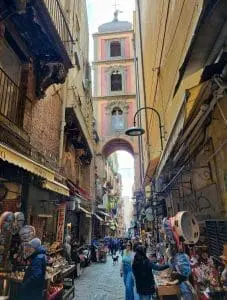 This modern art museum is named after the 14th century Gothic church within its walls. We will admit that we didn’t visit this museum because we’re not big art fans and we wanted to get everything else done during the day. But we wanted to bring you everything that is available, as you may enjoy looking at the art.
This modern art museum is named after the 14th century Gothic church within its walls. We will admit that we didn’t visit this museum because we’re not big art fans and we wanted to get everything else done during the day. But we wanted to bring you everything that is available, as you may enjoy looking at the art.
We looked into others reviews of the museum and a lot of people have said that it isn’t the best contemporary art museum out there. But you will find artwork from Andy Warhol, Damien Hirst, Sol LeWitt and Jeff Koons.
The price to enter is 8.00 Euros and the museum is open Monday, Wednesday, Thursday, Friday and Saturday between 10am and 7.30pm. It’s also open on Sunday between 10am and 8pm but is closed on a Tuesday.
San Carlo Theatre
Sadly, another attraction we didn’t get to see but we thought you should be aware of, is the San Carlo Theatre. This UNESCO World Heritage Site is one of the most striking in Europe. The Teatro di San Carlo opened in 1737 and the neoclassical building is the oldest continuously running public opera venue in the world.
The theatre offers the traditional horseshoe-shaped auditorium which is painted with dazzling frescoes, and a red and gold décor. Guided tours are available in English and Italian for the main auditorium, the royal box and the two foyers. Because it’s a tour, you can only visit at set times between Monday and Saturday, so make sure you check out their website. But it’s 9 Euros which is quite a reasonable price for a tour.
Castel Nuovo (New Castle)
This imposing medieval castle can be found next to the Naples port terminal, so it’s ideal if you’re there on a cruise stop. It was originally built between 1279 and 1282 by King Charles of Anjou, but French rule ended in the mid-15th century and the Spanish Empire took over. Castel Nuovo was then completely rebuilt by Alfonso V of Aragon, creating the medieval renaissance style fortress that you can see today.
If you want to visit, then you can go either Monday to Saturday between 8.30am and 6pm, or on Sundays between 10am and 1pm. The entrance charge is 6 Euros which isn’t that steep compared to many other historic buildings. As you stroll the grounds and towering walls, you can enjoy incredible views of the bay. Castel Nuovo has five round towers and a white marble arch entrance, between the two watch towers.
Inside is the Capella Palatina or Palatine Chapel which is home to beautiful frescoes from artists such as Giotto. There is an Armoury Hall where you will find Roman ruins under the glass floor, the Hall of the Barons which was originally the castles Throne Room. Plus, there is a collection of artworks by Neapolitan painters from the 17th to the early 20th centuries.
Should I Visit Naples?
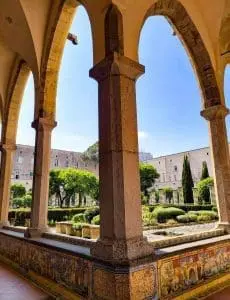 As you can see there is plenty to do in Naples, whether you’re there for a few hours during a cruise stop, enjoying a long weekend or staying for longer and exploring the Campania and Amalfi region. Naples is a great place to base yourself from, as there are extensive transport options all over the region.
As you can see there is plenty to do in Naples, whether you’re there for a few hours during a cruise stop, enjoying a long weekend or staying for longer and exploring the Campania and Amalfi region. Naples is a great place to base yourself from, as there are extensive transport options all over the region.
We chose not to stay in Naples, mainly because we were comfortable with driving in the area, and wanted to position ourselves more centrally. Because of this we enjoyed a lovely little apartment in the mountains in Agerola, preferring to get away from the hustle and bustle of a city or town. But we know this wouldn’t be suitable for everyone, and if you don’t want to drive then we completely understand, and we’d recommend either Naples or Sorrento to base yourselves out of.
Yes, Naples isn’t the prettiest city we have been to, there is lots of litter and graffiti which can be a little off putting. But we felt safe enough to wander around and there are plenty of other cities with the same problem, so we simply ignored it.
Our suggestion would be to spend a couple of nights in Naples and then move onto the Amalfi coast and stay in a hotel near there. This means you can enjoy the best of both worlds and do not have to commute back and forth each day. Yes, there is an array of transport options available but you don’t want to lose time getting to the various tourist spots, and then have to travel a distance back after a long day of walking.
We hope this guide has helped answer any questions you may have about Naples. Make sure you tag us on Instagram if you end up visiting the amazing city, we love to see what you’re up to as you tick off your bucket lists.
We also have our Guide to Travelling Around the Amalfi Coast and Campania Region, which provides you with an extensive list of the must visit towns and cities, plus the best things to do when you’re there.